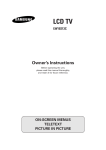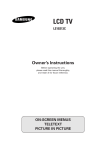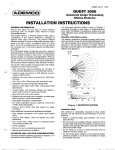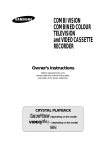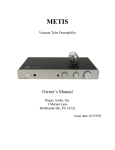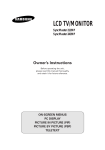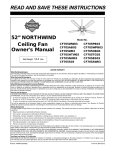Download Samsung CS-34Z6HF User Manual
Transcript
COLOUR TELEVISION Owner’s Instructions Before operating the unit, please read this manual thoroughly, and retain it for future reference. TELETEXT PICTURE IN PICTURE (OPTION) AV-LINK Safety Instructions ENG These illustrations represent precautions concerning your television. 10% 75% 35¡ H H 5¡ Do NOT expose the television to extreme temperature conditions (below 5°C and above 35°C) or to extreme humidity conditions (less than 10% and more than 75%). Do NOT expose the television to direct sunlight. Do NOT expose the television to any liquids. If the television is broken, do not try to repair it yourself. Contact qualified service personnel. During a storm conditions (especially when there is lightning) unplug the television from the mains socket and aerial. If the remote control is not used for a long period of time, remove the batteries and store it in a cool, dry place. THIS DEVICE IS NOT FOR USE IN INDUSTRIAL ENVIRONMENTS ☛ Displaying any stationary images that exceed the long time, it can cause uneven aging of picture tubes (CRTs) that leave subtle, but permanent burned-in ghost images in the television picture. To avoid this, vary the programming and images, and primarily display full screen moving images, not stationary patterns or dark bars. Caution CAUTION RISK OF ELECTRIC SHOCK DO NOT OPEN ! CAUTION: TO PREVENT ELECTRICAL SHOCK, DO NOT REMOVE REAR COVER, NO USER SERVICEABLE PARTS INSIDE. REFER SERVICING TO QUALIFIED SERVICE PERSONNEL. ☛ The main voltage is indicated on the rear of the TV set and the frequency is 50 or 60Hz. The lightning flash and arrow head within the triangle is a warning sign alerting you of “dangerous voltage” inside the product. The exclamation point within the triangle is a warning sign alerting you of important instructions accompanying the product. WARNING: TO PREVENT DAMAGE WHICH MAY RESULT IN FIRE OR SHOCK HAZARD. DO NOT EXPOSE THIS APPLIANCE TO RAIN OR MOISTURE. Mode 2 ! System CW/WS PAL-B/G, D/K, I, SECAM-B/G,D/K, I, L/L’, NTSC4.43 CS PAL-B/G, D/K, I, SECAM-B/G,D/K, I, NTSC4.43/3.58 Thank you for buying a SAMSUNG television. ENG Please take the time to read these instructions, as they will help you to operate your television with ease. Contents ◆ FOREWORD ■ ■ Safety Instructions ......................................................................................... Caution .......................................................................................................... 2 2 ◆ CONNECTING AND PREPARING YOUR TELEVISION ■ ■ ■ ■ ■ ■ ■ ■ ■ ■ ■ ■ ■ ■ Control Panels ............................................................................................... Connection Panel .......................................................................................... Infrared Remote Control ................................................................................ Connecting to an Aerial or Cable Television Network ................................... Connecting a non-AV-Link VCR .................................................................... Connecting a Satellite Receiver .................................................................... Connecting a Decoder................................................................................... Connecting Additional Speakers ................................................................... Inserting the Batteries in the Remote Control................................................ Switching Your Television On and Off........................................................... Placing Your Television in Standby Mode ..................................................... Becoming Familiar with the Remote Control ................................................. Plug and Play ................................................................................................ Choosing Your Language.............................................................................. 5 6 7 8 9 10 10 11 11 12 12 13 14 15 ◆ SETTING THE CHANNELS ■ ■ ■ ■ ■ ■ Automatic Storing of Channels ...................................................................... Sorting the Stored Channels ......................................................................... Manual Storing of Channels .......................................................................... Assigning Names to Channels ...................................................................... Activating the Child Lock and Skipping unwanted channels ......................... Selecting a Channel by Informations............................................................. 16 17 18 20 21 22 ◆ USING YOUR TELEVISION ■ ■ ■ ■ ■ ■ ■ ■ ■ ■ ■ ■ ■ ■ Changing the Scan Mode .............................................................................. Activating/Deactivating the Digital Noise Reduction Feature ........................ Using the Tilt Control Feature........................................................................ Using the LNA (Low Noise Amplifier) Feature (Option)................................. Setting the Blue Screen Mode....................................................................... Selecting the Picture Size.............................................................................. Changing the Picture Standard ..................................................................... Adjusting the Picture Settings........................................................................ Adjusting the Volume..................................................................................... Adjusting the Volume Automatically .............................................................. Switching the Sound Off Temporarily ............................................................ Selecting the Sound Mode ............................................................................ Selecting the Sound Standard....................................................................... Adjusting the Sound Settings ........................................................................ 3 22 23 23 24 24 25 26 26 27 27 28 28 29 29 ENG Contents (cont.) ◆ USING YOUR TELEVISION (cont.) ■ ■ ■ ■ ■ ■ ■ Setting the Dolby Pro-logic ............................................................................ Adjusting Your Dolby Preferences................................................................. Connecting Headphones ............................................................................... Adjusting Your Headphone Preferences ....................................................... Setting the Sleep Timer ................................................................................. Setting the Time and Switching the TV On/Off Automatically ....................... Picture In Picture Feature (Option)................................................................ 30 31 32 32 33 33 34 ◆ USING THE TELETEXT FEATURE ■ ■ ■ ■ Teletext Feature ............................................................................................ Displaying the Teletext Screen...................................................................... Selecting Display Options.............................................................................. Selecting a Teletext Page.............................................................................. 36 37 38 39 ◆ USING THE AV-LINK FEATURE ■ ■ ■ ■ ■ New AV-Link Feature .................................................................................... Connecting an AV-Link VCR ......................................................................... Setting Up Your AV-Link VCR ....................................................................... Recording Directly via the AV-Link Feature................................................... Setting the Programmed Record Timer......................................................... 40 40 41 42 43 ◆ ADDITIONAL INFORMATION ON CONNECTIONS ■ ■ ■ ■ ■ ■ ■ ■ ■ ■ Deciding How to Connect Up Your Audio/Video Systems............................. Connection Tips............................................................................................. Connecting to the Ext 1, 2 or 3 SCART Input/Outputs .................................. Connecting to the RCA Input......................................................................... Connecting to the S-Video Input.................................................................... Connecting to the Audio Output .................................................................... Connecting to the PC Input (Option) ............................................................. Viewing Pictures From External Sources ...................................................... Redirecting an Input to the Ext 2 or Ext 3 Output .......................................... SCART Connector Wiring (Ext 1, Ext 2 or Ext 3) .......................................... 44 45 46 46 47 47 48 49 49 50 ◆ RECOMMENDATIONS FOR USE ■ ■ Wiring the Mains Power Supply Plug (UK Only)............................................ Troubleshooting: Before Contacting Service Personnel................................ Symbols Press 4 Push Hold down ☛ ➢ Important Note 50 51 Control Panels ➢ The actual configuration on your TV may be different, depending on your model. ENG ❶ TV/VIDEO SELECTION ❺ POWER ❷ ACCESS TO LOCAL MENU ❻ STAND-BY INDICATOR ❸ VOLUME ADJUSTMENT ❼ REMOTE CONROL SENSOR ❹ CHANNEL SELECTION ➣ Using the Buttons on the Panel If the remote control no longer works or you have lost it, you can use controls on the panel of the television to: ◆ Switch on the television when it is in Standby mode and select channels ( ▼ C/P. ◆ Access the local menu ( LOCAL MENU ) ◆ Adjust the volume ( - ◆ Switch among Video inpt modes ( TV/VIDEO or ▼ C/P. ▲) +) ▲ ) - depending on the model 5 Connection Panel ➢ ENG The actual configuration on your TV may be different, depending on your model. Rear of TV R L R L REAR SPEAKER (16Ω) AUDIO OUT WOOFER R L REAR SPEAKER (16Ω) C CENTER SPEAKER (8Ω) L R AUDIO OUT C CENTER SPEAKER (8Ω) 75Ω 75Ω EXT2 (VCR) EXT2 (VCR) VHF/UHF EXT1 VHF/UHF EXT3 (DECODER) EXT1 AV-link AV-link ❶ SPEAKER CONNECTORS ❷ RCA AUDIO OUTPUT CONNECTORS ❸ WOOFER SPEAKER CONNECTOR (OPTION) ❹ CENTER SPEAKER CONNECTORS (OPTION) ❺ FULL RGB AV-LINK INPUT/OUTPUT CONNECTOR ❻ VIDEO/S-VIDEO INPUT/OUTPUT CONNECTOR ❼ VIDEO INPUT/OUTPUT CONNECTOR, RGB ❽ 75Ω COAXIAL CONNECTOR FOR AERIAL/CABLE NETWORK Side of TV Front of TV S-VIDEO VIDEO (MONO)L-AUDIO-R ❶ RCA AUDIO INPUT CONNECTORS ❷ RCA VIDEO INPUT CONNECTOR ❸ S-VIDEO INPUT CONNECTOR ❹ HEADPONE CONNECTOR ❺ PC INPUT CONNECTOR (OPTION) 6 EXT3 (DECODER) Infrared Remote Control (depending on the model) ENG AV-LINK VCR STOP AV-LINK VCR RECORD AUTOMATIC SWITCH-OFF VCR FUNCTIONS; (STOP/REWIND/PLAY/PAUSE/ FAST-FORWARD) Power TELEVISION STANDBY BUTTON PIP FUNCTIONS (OPTION); PIP ON/SWAP/LOCATE/ SIZE SETTING/STILL/SCAN/ CHANNEL SELECTION(P)/ MULTI PIP/ SOURCE SELECTION (TV/VIDEO) ➢ If the “PIP” is “Off”, the STILL button used to freeze the main picture. NUMERIC BUTTONS EXTERNAL INPUT SELECTION TEMPORARY SOUND SWITCH OFF MAKE THE REMOTE CONTROL WORKS FOR TV, VCR, CABLE, DVD PLAYER TUNER/CABLE NETWORK SELECTION MENU DISPLAY/ PROGRAMME SELECTION BY NAME NEXT CHANNEL/ TELETEXT NEXT PAGE CONTROL THE CURSOR IN THE MENU VOLUME DECREASE VOLUME INCREASE CHANGE CONFIRMATION TELETEXT SUB-PAGE ON-SCREEN DISPLAY/ TELETEXT REVEAL PREVIOUS CHANNEL/ TELETEXT PREVIOUS PAGE PICTURE SIZE/TELETEXT SIZE TELETEXT DISPLAY/MIX SOUND MODE SELECTION/ TELETEXT CANCEL INFORMATION DISPLAY SCAN MODE SELECTION FASTEXT TOPIC SELECTION SOUND STANDARD SELECTION ➢ PICTURE STANDARD SELECTION It is possible that the work of the transmitter is dull or not operated normally if the light of the Bulb is on around the TV set. 7 Connecting to an Aerial or Cable Television Network ENG To view television channels correctly, a signal must be received by the set from one of the following sources: ◆ An outdoor aerial ◆ A cable television network ◆ A satellite network (see page 10 for further details) Rear of the TV 75Ω or Cable Television Network 1 In the first three cases, connect the aerial or network input cable to the 75Ω coaxial socket on the rear of the television. 2 If you are using an indoor aerial, you may need to turn it when tuning your television until you obtain a picture that is both sharp and clear. For further details, refer to: ◆ “Automatic Storing of Channels” on page 16 ◆ “Manual Storing of Channels” on page 18 ➢ 8 If you wish to subscribe to a cable network, contact your local dealer. Connecting a non-AV-Link VCR ENG You can connect a VCR to the television using a: ◆ Coaxial cable Rear of the TV ◆ SCART cable 75Ω ◆ S-Video cable EXT2 (VCR) VHF/UHF EXT3 (DECODER) EXT1 AV-link 1 Plug the aerial input cable into the appropriate socket on the VCR. 2 Connect a coaxial cable to the: ◆ VCR aerial output socket ◆ Television aerial input socket 3 To obtain better picture quality and, in addition, simplify the setting up procedure of the VCR, you can connect a SCART cable between: ◆ The AV (SCART) socket on the VCR and ◆ A SCART socket on the rear of the television (see page 44 for further details on the various connection possibilities) ➢ 4 Aerial output SCART cable OUT TO TV DECODER L G AV M IN FROM ANT. ATT. A M TEST A COUL N/B It is recommended that you use the Ext 2 connector as it can process a Y/C signal (luminance and chrominance). Aerial input Follow the instructions supplied with your VCR to tune the VCR to your television. 9 Connecting a Satellite Receiver ENG In order to watch television programmes broadcast via a satellite network, you must connect a satellite receiver to the TV set. ➢ Rear of the TV 75Ω EXT2 (VCR) VHF/UHF EXT3 (DECODER) EXT1 AV-link If you wish to connect both a satellite receiver and a VCR, you should connect the: ◆ Receiver to the VCR ◆ VCR to the television (see pages 44~47 for further details) Otherwise, connect the receiver directly to the television. or Using a SCART cable Connect the receiver SCART cable to one of the SCART connectors on the rear of the television (see page 44 for further details on the various connection possibilities). Satellite receiver Using a coaxial cable Connect a coaxial cable to the: ◆ Receiver output socket. ◆ Television aerial input socket. Connecting a Decoder In order to descramble a coded transmission signal, you must connect a decoder to the TV set. ➢ Rear of the TV 75Ω EXT2 (VCR) VHF/UHF EXT3 (DECODER) EXT1 AV-link If you wish to connect both a decoder and a VCR, you should connect the: ◆ Decoder to the VCR ◆ VCR to the television (see pages 44~47 for further details) Otherwise, connect the decoder directly to the television. or Using a SCART cable Decoder Connect the receiver SCART cable to one of the SCART connectors on the rear of the television (see page 44 for further details on the various connection possibilities). Using a coaxial cable Connect a coaxial cable to the: ◆ Receiver output socket. ◆ Television aerial input socket. 10 Connecting Additional Speakers ENG If you wish to listen a programme or recording using Dolby Surround, you can connect additional speakers. The four speaker terminals are located on the rear of the television: ◆ Two for the left-hand speaker (marked L) ◆ Two for the right-hand speaker (marked R) ◆ Two for the centre speaker (marked C); Option To improve the quality of the sound, connect the: ◆ Red wire to the red terminal ◆ Black wire to the black terminal R L REAR SPEAKER (16Ω) C CENTER SPEAKER (8Ω) OPTION 1 To connect a wire to a terminal, push the tab back as far as it will go. 2 Insert the wire, up to the plastic sheathing, in the hole. 3 Release the tab. The wire is pinched and held firmly in place. Result: 4 Repeat the operation for each wire. 5 Connect the other end of the wires to the loudspeakers. Rear of the TV Inserting the Batteries in the Remote Control You must insert or replace the batteries in the remote control when you: ◆ Purchase the television ◆ Find that the remote control is no longer operating correctly 1 Remove the cover on the rear of the remote control by pressing the symbol downwards and then pulling firmly to remove it. 2 Insert two R03, UM4, “AAA” 1.5V or equivalent batteries taking care to respect the polarities: ◆ + on the battery against + on the remote control ◆ - on the battery against - on the remote control 3 Replace the cover by aligning it with the base of the remote control and pressing it back into place. ➢ Do not mix battery types, i.e. alkaline and monganese. 11 Switching Your Television On and Off ENG The mains lead is attached to the rear of your television. ☛ 1 If you have purchased this television in the United Kingdom, refer to page 50 for further instructions on plug wiring. Plug the mains lead into an appropriate socket. ➢ The main voltage is indicated on the rear of the TV and the frequency is 50 or 60Hz. 2 Press the ON/OFF button ( ) on the front of the television. The Standby indicator lights up on the front panel. Result: 3 Press the POWER button ( ) on the remote control to switch the television on. The programme that you were watching last is reResult: selected automatically. ➢ When you switch the television on for the very first time, you will be asked to choose the language in which the menus are to be displayed (see page 14). 4 To switch your television off, press the ON/OFF button ( again. ) Placing Your Television in Standby Mode Your television can be placed in Standby mode, in order to reduce: ◆ Power consumption ◆ Wear of the cathode ray tube The Standby mode can be useful when you wish to interrupt viewing temporarily (during a meal, for example). 1 Press the POWER button ( Result: 2 The screen is turned off and a red Standby indicator appears on the front of the television. To switch the television back on, simply press the POWER button ( ) again or a number button. ➢ 12 ) on the remote control. Do not leave your television in Standby mode for long periods of time (when you are away on holiday, for example). Turn your television off by pressing the ON/OFF button ( ) on the front of the television. It is best to unplug the set from the mains and aerial. Becoming Familiar with the Remote Control ENG The remote control is used mainly to: ◆ Change channels and adjust the volume ◆ Set up the television using the on-screen menu system The following table presents the most frequently used buttons and their functions. Button Viewing Function Menu Function P Used to display the next stored channel. - P Used to display the previous stored channel. - ➢ For double digit channels, the second digit must be pushed immediately after the first. Failure to do this will result in a single digit channel being displayed. Used to increase the volume. - Used to reduce the volume. - - Used to: ◆ Display a submenu containing selections for the current menu option ◆ Search forwards/backwards manually for channels ◆ Increase/reduce a menu option value - Used to confirm your choice. MENU Used to display the on-screen menu system. Used to return to the previous menu or normal viewing. to Used to display the corresponding channels. Used to display the corresponding channel directly. Used to switch the television on when it is in Standby mode. Used to exit the menu system and return to normal viewing directly. TV ( ) 13 Plug and Play ENG When the television is initially powered ON, several basic customer settings proceed automatically and subsequently. The follwing settings are available. 1 If the television is in Standby mode, press the POWER button ( on the remote control. Result: The message Plug & Play is displayed. It flickers for a little while, and then the Language menu is automatically displayed. 2 Select the appropriate language by moving the joystick up or down. 3 Press the joystick button ( Result: 4 ) to confirm your choice. The message Antenna input check is displayed. Make sure that the antenna is connected to the TV, and then press the joystick button ( ). Result: The Country (or Area) menu is displayed; (depending on the model). 5 Select your country (or area) by moving the joystick up or down. 6 Press the joystick button ( Result: 7 ➢ 8 ) to confirm your choice. The ATM (or Auto store) menu is displayed; (depending on the model). To start the search, press the joystick button ( Result: 14 ) ). The search will end automatically. Channels are sorted and stored in an order which reflacts their position in the frequency range, (with lowest first and highest last). The programme originally selected is then displayed. To stop the search before it has finished or return to normal viewing, press the TV button ( ). When it has finished, the message Enjoy viewing your new TV is displayed, and then the channel which has been stored will be activated. Plug and Play (cont.) ENG If you want to reset this feature... 1 Function Press the MENU button. The main menu is displayed. Result: English Language AV Setup 2 Move the joystick up or down until the Function is selected. The options available in the Function group are Result: displayed. 3 Move the joystick right. 4 Move the joystick up or down until the Plug & Play option is selected. 5 Move the joystick right. Result: 6 Time Blue screen Off Plug & Play Move: Enter: The message Plug & Play is displayed. For further details on how to set, refer to the opposite page. Choosing Your Language When you start using your television for the first time, you must select the language which will be used for displaying menus and indications. 1 Press the MENU button. The main menu is displayed. Result: 2 Move the joystick up or down until the Function is selected. The options available in the Function group are Result: displayed. 3 Move the joystick right. The Language option is selected. Result: 4 Move the joystick right again. The languages available are listed. Result: Language 5 Move the joystick up or down until the appropriate language is selected. Blue screen 6 Press the joystick button ( 7 When you are satisfied with your choice, press the TV button ( to return to normal viewing. Function English AV Setup Time ) to confirm your choice. Off Plug & Play Move: Enter: ) 15 Automatic Storing of Channels ENG You can scan for the frequency ranges available to you, (availability depends on your country). Automatically allocated programme numbers may not correspond to actual or desired programme numbers. However you can sort numbers manually and clear any channels you do not wish to watch (see pages 17~18 for further details). 1 Press the MENU button. The main menu is displayed. Result: 2 Move the joystick up or down until the Channel is selected. The options available in the Channel group are Result: displayed. 3 Move the joystick right. The Country (or Area) option is selected. Result: 4 Move the joystick right again. The countries (or areas) available are listed. Result: 5 Move the joystick up or down to select your country. ➢ If you have selected the Others option but do not wish to scan the PAL frequency range, store the channels manually (see page 18). 6 Press the joystick button ( 7 Press the MENU button. The options available in the Channel group are Result: displayed again. 8 Move the joystick up or down to select the ATM (or Auto store). 9 Move the joystick right. The ATM (or Auto store) menu is displayed. Result: 10 Press the joystick button ( Country Austria Belgium Croatia Denmark Finland France Sel.: Store: Area Asia/W.Europe ) to confirm your choice CIS/E.Europe China Hongkong/UK Australia NZ/Indonesia Sel.: Store: ATM Country Result: 35 % 227 MHz P 0 ----Exit:TV ➢ Auto store Area Asia/W.Europe 35 % 227 MHz ) to start the search. Austria P 0 ----Exit:TV 16 11 The search will end automatically. Channels are sorted and stored in an order which reflacts their position in the frequency range, (with lowest first and highest last). The programme originally selected is then displayed. To stop the search before it has finished, press the TV button ( ). When the channels have been stored, you can: ◆ Sort them in the order required (see page 17) ◆ Clear a channel (see page 21) ◆ Fine-tune channel reception if necessary (see page 19) ◆ Assign a name to the stored channels (see page 20) ◆ Activate/deactivate the Digital Noise Reduction feature (see page 23) Sorting the Stored Channels ENG The Sort operation allows you to change the programme numbers of stored channels. This operation may be necessary after using ATM. You can delete those channels you do not want to keep. Channel Country Austria ATM 1 2 Press the MENU button. The main menu is displayed. Result: Manual store Sort Name Channel edit Move the joystick up or down until the Channel is selected. The options available in the Channel group are Result: displayed. 3 Move the joystick right. 4 Move the joystick up or down until the Sort option is selected. 5 Move the joystick right. The Sort menu is displayed. Result: Move: Enter: Sort 6 Move the joystick up or down to select the channel that you wish to move. Then move the joystick right. 7 Move the joystick up or down to select the number of the programme to which the channel is to be moved. 8 Move the joystick left. The channel is moved to its new position and all other Result: channels are shifted accordingly. 9 Repeat Steps 6 to 8 until you have moved all the channels to the required programme numbers. 96 97 98 99 0 --------------------- 1 C 21 2 3 4 5 6 7 8 ----------------------------- 96 97 98 99 0 --------------------- Move: Sel.: Exit:TV Sort 1 C 21 2 3 4 5 6 7 8 C 21 ----------------------------- Move: Add : Exit:TV 17 Manual Storing of Channels ENG You can store up to 100 television channels, including those received via cable networks. When storing channels manually, you can choose: ◆ Whether or not to store each of the channels found ◆ The programme number by which you wish to identify each stored channel Channel Country 1 Press the MENU button. The main menu is displayed. Result: 2 Move the joystick up or down until the Channel is selected. The options available in the Channel group are Result: displayed. 3 Move the joystick right. 4 Move the joystick up or down until the Manual store option is selected. 5 Move the joystick right. The Manual store menu is displayed. Result: 6 If necessary, indicate the broadcasting standard required by moving the joystick up or down to select the Color system option, followed by moving the joystick left or right. The color standards are displayed in the following order (depending on your model) : Austria ATM Manual store Sort Name Channel edit Move: Enter: Manual store Prog.No. P Color system AUTO Sound system 1 BG Search 471 MHz Channel S04 ➞ Auto ➞ PAL ➞ SECAM Fine tune Move: Sel.: Store: or ➞ Auto ➞ NTSC3.58 (option) ➞ NTSC4.43 ➞ PAL60 Manual store Prog.No. P Color system AUTO 1 Sound system BG Search 471 MHz Channel S04 Fine tune Move: 7 Select the Sound system option by moving the joystick up or down, and followed by moving the joystick left or right. The sound standards are displayed in the following order (depending on your model) : ➞ BG ➞ DK ➞ I ➞ L (or M) Sel.: 18 Store: Manual Storing of Channels (cont.) ENG 8 If you... Then move the joystick... Know the number of the channel to be stored ◆ up or down to select the Channel option ◆ left or right to indicate the required number Do not know the channel numbers Result: 9 P Color system AUTO ◆ You can ignore any changes made and return to the previous setting by pressing the green button. ◆ If you are unable to fine-tune a channel, check that the Color system and Sound system settings are correct. To assign a programme number to a channel, select the Prog.No. option. Move the joystick left or right until you find the correct number. 11 To store the channel and associated programme number, press the joystick button ( ). 12 Repeat Steps 8 to 11 for each channel to be stored. 1 Sound system BG Search 471 MHz Channel S04 Fine tune Move: Sel.: The tuner scans the frequency range until the first channel or the channel that you selected is received on your screen. If reception is weak, you can fine-tune a channel manually by: ◆ Selecting the Fine tune option ◆ Moving the joystick left or right until the picture and sound are both clear and sharp. ➢ 10 ◆ up or down to select the Search option ◆ left or right to start the search Manual store Prog.No. Store: Manual store Prog.No. P Color system AUTO Sound system 1 BG Search 471 MHz Channel S04 Fine tune Move: Enter: Store: Manual store Prog.No. P Color system AUTO Sound system 1 BG Search 471 MHz Channel S04 Fine tune Move: Adjust: Store: Manual store Prog.No. P Color system AUTO Sound system 1 BG Search 471 MHz Channel S04 Fine tune Move: Sel.: 19 Store: Assigning Names to Channels ENG Channel names will be assigned automatically when channel information is broadcast. These names can be changed, allowing you to assign new names. Channel Country Austria 1 Press the MENU button. The main menu is displayed. Result: 2 Move the joystick up or down until the Channel is selected. The options available in the Channel group are Result: displayed. 3 Move the joystick right. 4 Move the joystick up or down until the Name option is selected. 5 Move the joystick right. The Name menu is displayed with the current channel Result: automatically selected. 6 If necessary, select the channel to be assigned a new name by moving the joystick up or down. 7 Move the joystick right. Arrow indications are displayed around the name box. Result: 8 To... Then move the joystick... Select a letter, number or symbol up or down. Move on the next letter right. Move back the previous letter left. ATM Manual store Sort Name Channel edit Move: Enter: Name 96 97 98 99 0 --------------------- 1 C 21 2 3 4 5 6 7 8 ----- ----------------------------- Move : Enter: Exit :TV ➢ Name 96 97 98 99 0 --------------------- 1 C 21 2 3 4 5 6 7 8 9 When you have finished entering the name, press the joystick button ( ) to confirm the name. 10 Press the TV button ( A1_B- ----------------------------- 20 Move : Sel. : Store: Exit :TV The characters available are: ◆ Letters of the alphabet (A ... Z) ◆ Numbers (0 ... 9) ◆ Special characters (_, –, space) ) to return to normal viewing. Activating the Child Lock and Skipping unwanted channels ENG ◆ Activating the child lock You can restrict viewing by locking the channels of your choice. For example, you can prevent your children from watching unsuitable programmes. ◆ Skipping unwanted channels You can exclude the channels of your choice from the channel scan operation. When you scan through the stored channels, those that you have chosen to skip are thus not displayed. All channels that you do not specifically choose to skip are displayed during scanning. Channel 1 Press the MENU button. The main menu is displayed. Result: Country Austria ATM Manual store 2 Move the joystick up or down until the Channel is selected. The options available in the Channel group are Result: displayed. 3 Move the joystick right. The Channel menu is displayed. Result: 4 Move the joystick up or down until the Channel edit option is selected. 5 Move the joystick right. The Channel edit menu is displayed with the current Result: channel automatically selected. 6 Move the joystick up or down to select the number of the programme to which the channel is to be locked. 7 Move the joystick right. 8 To... Then... Lock the channel ◆ Select On. ◆ Press the joystick button ( ). Result: The channel is locked. Unlock the channel ◆ Select Off. ◆ Press the joystick button ( ). Result: The channel is unlocked. 9 Move the joystick right. 10 To... Then... Erase the channel ◆ Select Erased. ◆ Press the joystick button ( ). Result: The channel is erased. Add the channel ◆ Select Added. ◆ Press the joystick button ( ). Result: The channel is added. 11 Press the TV button ( Sort Name Channel edit Move: Enter: Channel edit 96 97 98 99 0 --------------------- 1 C 21 2 3 4 5 6 7 8 ----------------------------- 96 97 98 99 0 --------------------- Child Lock on Added Move : Sel. : Store: Exit :TV Channel edit 1 C 21 2 3 4 5 6 7 8 Add Erase on ----------------------------- Added Move : Sel. : Store: Exit :TV ) to return to normal viewing. 21 Selecting a Channel by Informations ENG You can display the list of stored channels. 1 Press the INFO. button. A list is displayed with the first 13 channels. Two text Result: boxes to the right of the list indicate: ◆ Whether the Teletext feature is available. ◆ Which sound mode is being used. 2 To... Then... Scroll through the stored channels Move the joystick up or down. Result: The corresponding channel is displayed. Select a specific channel Press the TV button ( ). Result: The corresponding channel is displayed and the Information box disappears. Information 96 97 98 99 0 ------------DSF MTV TTX 1 KBS1 2 3 4 5 6 7 8 Stereo MBC KBS2 ZDF 3 SAT ARD SUPER VIVA2 ➢ Sel.: ◆ External inputs can be displayed and scrolled through in the same way. ◆ You can display the name of the channel or input by pressing the DISPLAY button ( ). Changing the Scan Mode Picture Adjust Custom Scan mode Natural scan Digital NR Off Tilt You will normally find that scan mode is best set to on to reduce any slight picture filcker. However, it is possible that some occasional broadcasts may benefit by changing the scan mode. The following scan modes are available (depending on the model): ◆ Natural scan, Digital scan, Progressive. 0 Size Normal Move: 1 Press the MENU button. The options available in the Picture group are Result: displayed. 2 Move the joystick right. 3 Move the joystick up or down until the Scan mode option is selected. Move the joystick right. Result: The Scan mode menu is displayed with the current option. 4 To... Then... Change the option Move the joystick left or right. Confirm the option Press the joystick button ( Return to normal viewing Press the TV button ( Enter: Scan mode Natural scan Sel.: Store: ☛ 22 You can also set these options by simple pressing the SCAN-MODE button on the remote control. ). ). Activating/Deactivating the Digital Noise Reduction Feature ENG If the signal received by your television is weak, you can activate the Digital Noise Reduction feature to help reduce any static and ghosting that may appear on the screen. 1 Picture Press the MENU button. The options available in the Picture group are Result: displayed. 2 Move the joystick right. 3 Move the joystick up or down until the Digital NR option is selected. Move the joystick right. The Digital NR menu is displayed with the current Result: option. Adjust Custom Scan mode Natural scan Digital NR Off 0 Tilt Size Normal Move: 4 Enter: Digital NR On To... Then... Change the option Move the joystick left or right. Confirm the option Press the joystick button ( Return to normal viewing Press the TV button ( Sel.: Store: ). ). Using the Tilt Control Feature If you find that the picture received is slightly tilted to one side, you can adjust the tilt setting. Picture 1 Press the MENU button. The options available in the Picture group are Result: displayed. Adjust Custom Scan mode Natural scan Digital NR Off 0 Tilt 2 Move the joystick right. 3 Move the joystick up or down until the Tilt option is selected. Move the joystick right. The Tilt menu is displayed with the current option. Result: 4 To... Then... Adjust a setting Move the joystick left or right. Confirm the setting Press the joystick button ( Return to normal viewing Press the TV button ( Size Normal Move: Enter: Tilt ). Adjust: Store: ). 23 Using the LNA (Low Noise Amplifier) Feature (Option) ENG Function English Language AV Setup Time Blue screen This function is very useful in the situation that the TV is used in weak signal. LNA amplifies the TV signal in the weak signal area, but not noise. This feature is working only weak signal condition, and that is memorized on current channel, additional. Off Plug & Play 1 Press the MENU button. The main menu is displayed. Result: 2 Move the joystick up or down until the Function is selected. The options available in the Function group are Result: displayed. 3 Move the joystick right. 4 Move the joystick up or down until the LNA option is selected. The LNA menu is displayed with the current option. Result: 5 To... Then... Change a setting Move the joystick up or down. Confirm the option Press the joystick button ( Return to normal viewing Press the TV button ( LNA Move: Enter: LNA 96 97 98 99 0 --------------------- 1 C 21 2 3 4 5 6 7 8 On ----------------------------- Sel. : Store : Exit :TV ). ). Setting the Blue Screen Mode Function English Language AV Setup If no signal is being received or the signal is very weak, a blue screen automatically replaces the noisy picture background. If you wish to continue viewing the poor picture, you must set the “Blue screen” mode to “Off”. Time Blue screen Off 1 Press the MENU button. The main menu is displayed. Result: 2 Move the joystick up or down until the Function is selected. The options available in the Function group are Result: displayed. 3 Move the joystick right. 4 Move the joystick up or down until the Blue screen option is selected. 5 To... Then... Change the option Move the joystick right. Return to normal viewing Press the TV button ( Plug & Play Move: Sel.: 24 ). Selecting the Picture Size ENG You can select the picture format which best corresponds to your viewing requirements. The following picture formats are available (depending on the model): Picture ◆ Auto wide, Panorama, 16:9, 4:3, Zoom1, Zoom2 Adjust Custom Scan mode Natural scan ◆ Normal, 16:9, Zoom Digital NR Off 0 Tilt Size 1 Press the MENU button. The options available in the Picture group are Result: displayed. 2 Move the joystick right. 3 Move the joystick up or down until the Size option is selected. Move the joystick right. The Size menu is displayed with the current option. Result: 4 To... Then... Change a setting Move the joystick left or right. Result: The picture is changed accordingly. Confirm the option Press the joystick button ( Return to normal viewing Press the TV button ( Normal Move: Enter: Size Normal Sel.: Store: VGA Mode Size ). Adjust ). Store: ☛ ☛ Exit:TV If the PC is connected, you can adjust the VGA mode by moving the joystick up, down, left, or right. You can also select these options by simple pressing the P.SIZE button on the remote control. 25 Changing the Picture Standard ENG You can use your remote control to select the type of picture which best corresponds to your viewing requirements. The following picture effects are available: ◆ Custom, Standard, Sports, Mild, Natural. To select the required picture effect, simply press the P.STD button ( ) on the remote control. ☛ You can also set these options via the Adjust option in the Picture group. If you change the Color tone, Brightness, Color, Contrast, Sharpness or Tint (NTSC only) settings on the Picture menu, the Custom option is selected automatically. Adjusting the Picture Settings Your television has several settings which allow you to control picture quality: Picture Adjust Custom Scan mode Natural scan Digital NR Off ◆ Color tone, Brightness, Color, Contrast, Sharpness, Tint (NTSC only) 0 Tilt Size Normal Move: 1 Press the MENU button. The options available in the Picture group are Result: displayed. 2 Move the joystick right. The Adjust option is selected. Result: 3 Move the joystick right again. The Adjust menu is displayed with the current option. Result: 4 Move the joystick up or down to select the option to be adjusted. 5 To change the... Then move the joystick... ◆ Color tone ◆ right until the required option (Normal, Warm1/2 or Cool1/2) is displayed. ◆ ◆ ◆ ◆ ◆ ◆ right. Result: A horizontal bar is displayed. ◆ left or right until you reach the setting. Enter: Adjust(Custom) Color tone Normal Brightness Color Contrast Sharpness Move: Sel.: 26 Store: Brightness Color Contrast Sharpness Tint (NTSC only) 6 When you are satisfied with the settings, press the joystick button ( ) to store them. 7 When you have finished, press the TV button ( normal viewing. ) to return to Adjusting the Volume ENG You can adjust the volume using your remote control. To... hold down the... Increase the volume + button. Result: A horizontal bar is displayed and the volume increases until you release the button. The cursor moves to the right to indicate the volume. Decrease the volume button. Result: A horizontal bar is displayed and the volume decreases until you release the button. The cursor moves to the left to indicate the volume. ➢ Volume Additional sound adjustments are available on your television. For further details, refer to pages 27 to 32. Adjusting the Volume Automatically Each broadcasting station has its own signal conditions, and so it is not easy for you to adjust the volume every time the channel is changed. Auto volume lets you automatically adjust the volume of the desired channel by lowering the sound output when the modulation signal is high or by raising the sound output when the modulation signal is low. 1 Press the MENU button. The main menu is displayed. Result: 2 Move the joystick up or down until the Sound is selected. The options available in the Sound group are displayed. Result: 3 Move the joystick right. 4 Move the joystick up or down until the Auto volume option is selected. 5 Select the required option by moving the joystick left or right. 6 Press the TV button ( Sound Adjust Custom Headphone Auto volume On Surround Off Audio out Standard Int. mute Off Move: Sel.: ) to return to normal viewing. 27 Store: Switching the Sound Off Temporarily ENG You can switch the sound off temporarily. Example: You wish to answer the telephone. 1 Press the MUTE button ( ) on the remote control. The sound is switched off and “ ” is displayed. Result: 2 When you wish to turn the sound back on, press the MUTE button ( ) again or either of the volume buttons. The sound comes back on at the same volume as Result: before and the “ “ indication disappears. Selecting the Sound Mode (depending on the model) The “S.MODE” button displays/controls the processing and output of the audio signal. When power is switched ON, the mode is automatically preset to either “Dual-I” or “Stereo”, depending on the current transmission. On-screen indication Regular broadcast (Standard audio) Mono (Normal use) Mono ↔ Mono Nicam (Normal) NICAM Stereo Stereo ↔ Mono Nicam (Normal) NICAM Dual-I/II Dual-I → Dual-II → Mono Nicam Nicam (Normal) A2 Stereo Regular broadcast (Standard audio) Mono (Normal use) Bilingual or Dual-I/II Dual-I ↔ Dual-II Stereo ➣ 28 → Regular + NICAM Mono → NICAM Stereo Type of broadcast Stereo ↔ Mono (Forced Mono) ◆ If the receiving conditions deteriorate, listening will be easier if the mode is set to the “Mono” position using the S.MODE button. ◆ If the stereo signal is weak (or if intermittent Stereo-Mono) and automatic switching occurs, then switch to the “Mono” mode. ◆ When receiving mono sound in the AV mode, connect to the “L” input jack on the panels. If the mono sound comes out only from the left speaker, then press the S.MODE button. Selecting the Sound Standard ENG You can use your remote control to select the type of special sound effect to be used when watching a given broadcast. The following sound effects are available: ◆ Custom, Standard, Music, Movie, Speech. To select the required sound effect, simply press the S.STD button ( ) on the remote control. ☛ You can also set these options via the Adjust option in the Sound group. Adjusting the Sound Settings The following settings can be adjusted to suit your personal preferences. The following settings are available: Sound ◆ Audio output Adjust ◆ Activation/deactivation of the internal speakers ◆ Volume, Balance, Equalizer 1 Press the MENU button. The main menu is displayed. Result: 2 Move the joystick up or down until the Sound is selected. The options available in the Sound group are displayed. Result: 3 Move the joystick right. 4 Move the joystick up or down until the Audio out option is selected. Custom Headphone Auto volume Off Surround Off Audio out Standard Int. mute Off Move: Sel.: Store: Sound Adjust Custom Headphone 5 Select the your requirement. ➢ 6 7 8 If you want to adjust the volume level with the volume control on the TV, set to Volume. When set to Standard, you can adjust the volume level with the volume control on the audio amplifier. Auto volume Off Audio out Standard Int. mute On Move: Sel.: R L 100 Adjust: 300 Move: Adjust to suit your personal preferences. ☛ Store: Adjust(Custom) If you wish to silence the internal speakers, set the Int. mute to On. Move the joystick up or down until the Adjust option is selected, and move the joystick right. The Adjust menu is displayed with the current option: Result: volume, balance, and equalizer. Off Surround If you make any changes to the Adjust settings, the sound standard is automatically switched to Custom. 29 1k 3k 10k Store: Setting the Dolby Pro-logic ENG The Dolby mode allows you enjoy Dolby prologic surround effect fully with only surround speakers are connected to TV. Rear of TV (depending on the model) R This allows various modes for the main, center and rear speakers to be selected. Surround Mode Input Signal Main L R L REAR SPEAKER (16Ω) AUDIO OUT R L REAR SPEAKER (16Ω) WOOFER L R AUDIO OUT C CENTER SPEAKER (8Ω) Stereo Mono ✔ - Phantom Stereo Mono ✔ ✔ - Wide Stereo Mono ✔ 3D Sound Stereo Mono ✔ ✔ Hall Stereo Mono ✔ ✔ Off Stereo Mono ✔ ✔ Pro Logic - Normal C CENTER SPEAKER (8Ω) Sound Adjust Custom Headphone Auto volume Off Surround Off Audio out Standard Int. mute Off Move: Enter: ➢ Off Sel.: Mode Pro Logic Pro Logic Normal Center Test tone Move: Enter: ✔ ✔ ✔ ✔ ✔ ✔ ✔ ✔ ; Sound Move the joystick up or down until the Sound is selected. The options available in the Sound group are displayed. Result: 3 Move the joystick right. 4 Move the joystick up or down until the Surround option is selected, and move the joystick left or right. The following surround modes are available: Result: Pro Logic, 3D Sound, Hall, Off. 5 Select the Pro Logic option in the surround mode. The options available are displayed. Result: 6 Move the joystick up or down until the Pro Logic option is selected, and move the joystick right. 7 Select the required option by moving the joystick left or right. The following options are available: Result: Normal, Phantom, Wide. 8 To store the setting, press the joystick button ( ). Press the TV button ( ) to return to normal viewing. Store: Pro Logic Right Left Center Rear Mode ✔ 20 mS Off Rear Rear Normal Sel.: Store: 30 ✔ 2 Rear Time delay ✔ ✔ Press the MENU button. The main menu is displayed. Result: Store: Surround Rear 1 Surround Mode Speakers Centre Adjusting Your Dolby Preferences ENG The following Dolby settings can be adjusted to suit your personal preferences. Sound ◆ Volume of the centre and rear speakers Adjust ◆ Prologic delay time for the rear speakers (between 15 and 30 ms) Custom Headphone ◆ Activation/deactivation of the test tone to simulate the volume on each speaker Auto volume Off Surround Pro Logic Audio out Standard Int. mute Off Move: 1 Press the MENU button. The main menu is displayed. Result: 2 Move the joystick up or down until the Sound is selected. The options available in the Sound group are displayed. Result: 3 Surround Mode Pro Logic Pro Logic Normal Center Rear Move the joystick right. Time delay Test tone 4 5 6 Enter: Move the joystick up or down until the Surround option is selected, and move the joystick right. The Surround menu is displayed with the current Result: option. Move: Sel.: Store: Surround Select the Pro Logic option in the surround mode. The options available are displayed. Result: Mode Pro Logic Pro Logic Normal To... Then... Center Change a setting Move the joystick up or down. Time delay Rear Test tone Change the option Move the joystick left or right. Confirm the changes Press the joystick button ( Return to normal viewing Press the TV button ( ➢ 20 mS Off Move: 20 mS Off Adjust: ). ). Manufactured under license from Dolby Laboratories. “Dolby”, “Pro Logic”, and the double-D symbol are trademarks of Dolby Laboratories. 31 Store: Connecting Headphones ENG You can connect a set of headphones to your television if you wish to watch a television programme without disturbing the other people in the room. Plug a set of headphones into the 3.5 mm mini-jack socket on the panel of the television. Result: The sound is heard through the headphones. ➢ ➢ For further details on how to set your headphone preferences, refer to the section below. Prolonged use of headphones at a high volume may damage your hearing. Adjusting Your Headphone Preferences You can adjust the headphone settings to suit your preferences. The following headphone settings are available: Sound Adjust ◆ Volume, Bass, Treble, Balance. Custom Headphone Auto volume Off Surround Off Audio out Standard Int. mute Off Move: 1 Press the MENU button. The main menu is displayed. Result: 2 Move the joystick up or down until the Sound is selected. The options available in the Sound group are displayed. Result: 3 Move the joystick right. 4 Move the joystick up or down until the Headphone option is selected. Move the joystick right. The Headphone menu is displayed. Result: 5 To... Then... Change the option Move the joystick up or down. Change a setting Move the joystick left or right. Confirm the changes Press the joystick button ( Return to normal viewing Press the TV button ( Enter: Headphone Volume Bass Treble Balance Move: Adjust: 32 Store: ). ). Setting the Sleep Timer ENG You can select a time period of between 15 and 180 minutes after which the television automatically switches to Standby mode. 1 Press the SLEEP button ( ). The Sleep Timer menu is displayed. Result: 2 Move the joystick left or right to select the number of minutes after which the television switches to Standby. 3 Press the joystick button ( 4 Press the TV button ( ) to confirm your selection. ) to return to normal viewing. Sleep timer Off Sel.: Store: Setting the Time and Switching the TV On/Off Automatically You can set the television’s clock and set the On/Off timers so that the television will: ◆ Switch on automatically and tune to the channel of your choice at the time you select ◆ Switch off automatically at the time you select. Function English Language AV Setup Time Blue screen Off Plug & Play 1 2 3 Press the MENU button. The main menu is displayed. Result: Move: Move the joystick up or down until the Function is selected. Move the joystick right. Result: The options available in the Function group are displayed. Move the joystick up or down until the Time option is selected. Move the joystick right. The Time menu is displayed with the Clock option Result: selected. 4 Set the Clock by pressing the numeric buttons. 5 Move the joystick up or down to select the Timer. Then, select to on by moving the joystick left or right for switching on/off automatically. 6 Select the On time by moving the joystick up or down, followed by pressing the numeric buttons to switch on automatically. 7 In the same way, set the Off time to switch off automatically ➢ The clock setting will be re-activated when pressing the “ (ON/OFF) button on the front panel. Enter: Time Clock --:-- Timer Off On time --:-- Off time --:-- Move: Adjust:0~9 ” 33 Store: Picture In Picture Feature (Option) ENG PIP PIP On TV/Video TV Swap Size You can display a “Picture-In-Picture screen” within the main picture of TV program or Video input. In this way you can watch or monitor TV program or the Video input from any connected equipment while watching TV or other Video input. For information about connection of other equipment, refer to pages 46 and 47. Large Prog. No. P 01 Move: 1 Press the MENU button. The main menu is displayed. Result: 2 Move the joystick up or down until the PIP is selected. The options available in the PIP group are displayed. Result: 3 Move the joystick right. 4 To activate the PIP feature, set the PIP to on by moving the joystick left or right. 5 Move the joystick up or down to select the TV/VIDEO option. Then, select a source of the sub picture by moving the joystick left or right. The sources are displayed in the following order: Sel.: PIP PIP On TV/Video TV Swap Size Large Prog. No. P 01 Move: Sel.: ➞ TV ➞ Ext1 ➞ Ext2 ➞ Ext3 ➞ Ext4 PIP PIP On TV/Video TV Swap Size 6 To interchange the main picture and the sub picture, select the Swap option and move the joystick right. 7 Move the joystick up or down to select the Size option. Then, select a size of the sub to Large or Small by moving the joystick left or right. 8 Move the joystick up or down to select the Prog.No. option. You can select the channel that you want to view through sub picture by moving the joystick left or right. 9 To return to normal viewing, press the TV button ( Large Prog. No. P 01 Move: Enter: PIP PIP On TV/Video TV Swap Size Large Prog. No. P 01 Move: Sel.: PIP PIP On TV/Video TV Swap Size Large Prog. No. P 01 Move: Sel.: 34 ). Picture In Picture Feature (Option) ENG Remote-control functions while “PIP” is “On”: Features Description PIP ON Used to operate ON/OFF function of PIP directly. SWAP Used to interchange the main picture and the sub picture. ➢ When the main picture is in the Video mode and the sub picture is in the TV mode, you might not hear the sound of main picture when pressing the SWAP button after changing the sub picture channel. At this time, reselect the main picture channel. LOCATE Used to move the sub picture counterclockwise. P ▼/▲ Used to select the channel of sub picture. SIZE Used to select the type of sub picture (Large, Small). STILL Used to freeze the sub picture. ➢ Power If the “PIP” is “Off”, the STILL button used to freeze the main picture. SCAN Used to scan every memorized channel in order. To stop scanning, press it again. MULTI Used to view memorized channels to a maximum of 12 on the sub picture spontaneously. TV/VIDEO Used to assign a source of sub picture (TV, Ext1, Ext2, Ext3, Ext4). 35 Teletext Feature ENG Most television channels provide a written information service via Teletext. Information provided includes: ◆ Television programme times ◆ News bulletins and weather forecasts ◆ Sports results ◆ Travel information A B C D This information is divided into numbered page (see diagram). E Part Contents F A Selected page number. B Current page number or search indications. C Broadcasting channel identity. D Date and time. E Text. F Status information. FASTEXT information. ➢ 36 Teletext information is often divided between several pages displayed in sequence, which can be accessed by: ◆ Entering the page number ◆ Selecting a title in a list ◆ Selecting a coloured heading (FASTEXT system) Displaying the Teletext Screen ENG You can display Teletext information at any time on your television. ☛ For Teletext information to be displayed correctly, channel reception must be stable; otherwise: ◆ Information may be missing ◆ Some pages may not be displayed To activate the Teletext mode and display the contents page, follow the instructions below. 1 Select the channel providing the Teletext service, using the P ( ) or P ( ) buttons or the VIDEO button ( ). 2 Press the TEXT/MIX button to activate the Teletext mode. The contents page is displayed. Result: 3 If you wish to display the actual broadcast at the same time as the Teletext page, press the TEXT/MIX button again. 4 When you have finished, press the TV button ( viewing normally. ➢ ) to continue A message box containing the words “No Text Transmission” will be displayed if the selected channel does not carry a Teletext signal. 37 Selecting Display Options ENG When you have displayed a Teletext page, you can select various options to suit your requirements. To display... Press the... Both the Teletext information and the normal broadcast TEXT/MIX. ◆ Hidden text (answers to quiz games, for example) (reveal). ◆ The screen normally again (reveal) again. A secondary page by entering its number . The broadcast when searching for a page . The next page P ( ). The previous page P ( ). ◆ In letters the upper or lower half of the page ◆ To a full page ➢ 38 (size) repeatedly. To return to the normal display after using the reveal or size features, press the TV button ( ) again. Selecting a Teletext Page ENG You can enter the page number directly by pressing the numeric buttons on the remote control. 1 Enter the three-digit page number given in the contents, by pressing the corresponding numeric buttons. Result: The current page number is incremented until the requested page is reached. That page is then displayed. If the selected page is linked with several secondary pages, the secondary pages are displayed in turn. 2 If the FASTEXT system is used by the broadcasting company, the different topics covered on a Teletext page are color-coded and can be selected by pressing the coloured buttons on the remote control. Press the coloured button corresponding to the topic that you wish to select; the available topics are given on the status line. Result: The page is displayed with other colored information that can be selected in the same way. 3 To display the... Press the... Previous/Next page Corresponding colored button. Subpage 1. 4 button. ➢ The available subpages are appeared. 2. Select the required subpage. When you have finished, press the TV button ( to your normal broadcast. ) again to return 39 New AV-Link Feature ENG Your television is equipped with an AV-Link feature. Data received on your television can be directly transferred to an AV-Link equipped VCR. Devices connected via AV-Link can exchange information. WYSIWYR Principle The WYSIWYR (What You See Is What You Record) principle means that you can start recording on your VCR a programme that you are currently watching on your TV, simply by pressing the AV-Link Record button ( ) on the remote control. Example: If you have selected programme 3 on your TV, this programme number is sent to the VCR and the VCR starts recording the corresponding broadcast on its own tuner. Advantages: You can record a programme without having to: ◆ Switch on the VCR ◆ Select the same programme on the VCR ◆ Start recording by pressing the record button on the VCR remote control Automatic Channel Downloading The AV-Link feature also allows the channels to be automatically downloaded from the TV to the VCR. Connecting an AV-Link VCR To connect an AV-Link VCR to your television, you must use a SCART cable. Rear of the TV 75Ω EXT2 (VCR) VHF/UHF 1 Plug the aerial input cable into the appropriate socket on the VCR. 2 Connect one end of the SCART cable to the AV-Link EXT1 socket on the rear of the television. EXT3 (DECODER) EXT1 AV-link Aerial output ➢ SCART cable OUT TO TV DECODER L G AV-Link M You can only use the EXT1 socket on your television to connect the AV-Link VCR. 3 Connect the other end of the SCART cable to the appropriate AV-Link SCART socket on the VCR. 4 Select the EXT1 option and download the preset channels from your television to your VCR by following the indications on page 41. IN FROM ANT. ATT. A M TEST A COUL ➢ N/B Aerial input 40 As the EXT1 connection always receives the actual TV tuner signal, you do not need to tune your VCR to your television, as with a standard VCR. Setting Up Your AV-Link VCR ENG The connection between your television and the AV-Link VCR through the EXT 1 socket (refer to the opposite page) enables you to set up your AV-Link VCR automatically from your television via the on-screen menus. 1 Press the MENU button. The main menu is displayed. Result: 2 Move the joystick up or down until the Function is selected. The options available in the Function group are Result: displayed. 3 Move the joystick right. Function Language 4 5 Move the joystick up or down until the AV Setup option is selected. The AV Setup menu is displayed with the EXT1 option selected. Off Move: Enter: Move the joystick right again. The AV-Link menu is displayed with the current option. To... Then move the joystick... Transfer the preset channel tuning information from the TV to the VCR ◆ up or down to select the Preset Download option ◆ left or right to start Indicate that every programming change from the TV set is to be transferred to the VCR ◆ up or down to select the Auto Preset option ◆ left or right to select On Indicate that you connected a decoder to your VCR to unscramble encrypted channels 8 Blue screen Move the joystick right. Result: 7 Time Plug & Play Result: 6 English AV Setup AV Setup EXT1 AV-Link EXT2 Selectable Out EXT3 Decoder Out Move: Enter: AV-Link ◆ up or down to select the Decoder on VCR option ◆ left or right to select On To return to normal viewing, press the TV button ( Timer Programming Preset Download Auto Preset Off Decoder on VCR Off ). Move: Start: 41 Recording Directly via the AV-Link Feature ENG The AV-Link feature allows you to start recording on your VCR the programme you are watching on your TV, simply by pressing the AV-Link Record button ( ) on the remote control. ☛ 1 Select the required channel by pressing the P buttons ( ). Result: 2 42 ,P or VIDEO The selected channel is displayed on the TV screen. To start recording this channel, press the AV-lLink Record button ( ). Result: 3 If you are recording a source that is not directly available on the VCR’s tuner (a signal from a decoder or input via the front AV connections, for example), a warning message appears if you try to change channels or switch your TV to the standby mode, for example. Recording will stop only when reaching the end of the cassette tape. To stop recording, press the AV-link Stop button ( remote control. ) on the Setting the Programmed Record Timer ENG At any time, you can set the timer options to record a programme automatically on your AV-Link VCR. 1 Press the MENU button. The main menu is displayed. Result: 2 Move the joystick up or down until the Function is selected. The options available in the Function group are Result: displayed. 3 Move the joystick right. 4 Move the joystick up or down until the AV Setup option is selected. AV-Link Timer Programming Preset Download 5 Move the joystick right. The AV Setup menu is displayed with the EXT1 option Result: selected. Auto Preset On Decoder on VCR On Move: 6 Move the joystick right again. The AV-Link menu is displayed with the Timer Result: programming option selected. 7 Move the joystick right again. The Timer menu is displayed with the Prog.No. Result: option selected. Start: Timer C 21 Prog. No. 6 Date 8 To... Then... Select the option Move the joystick up or down. Change a setting Press the numeric buttons. Confirm the changes Press the joystick button ( ➢ Return to normal viewing ➢ 00.00. Start time 00:00 Stop time 00:00 Move: Adjust:0~9 ). The setting information is transferred to the VCR. Press the TV button ( ). ◆ You can decrease or increase the value of the Prog.No. respectively by moving the joystick left or right. ◆ The data is displayed as follows: Day.Month. 43 Start: Deciding How to Connect Up Your Audio/Video Systems ENG You must take into account several factors when deciding how to connect your audio and/or video systems. These are: ◆ The types of connectors available on your systems ◆ Systems connected permanently to the television (VCR for example) or temporary (camcorder for example) Your television is equipped with the following connectors. Connector Location Type Ext1 EXT1 AV-link Ext2 EXT2 (VCR) Ext3 EXT3 (DECODER) Ext4 (depending on the model) Side Direction Recommended Use Full RGB SCART In/Out ◆ ◆ ◆ ◆ SCART (Video or S-Video) In/Out ◆ VCR SCART (Video or RGB) In/Out ◆ VCR ◆ Decoder AV-Link VCR Satellite receiver Game console (RGB usually required) Video disc player (RGB usually required) RCA In ◆ Camcorder S-Video + audio In ◆ Camcorder with S-Video output Coaxial In ◆ Aerial or cable television network ◆ VCR to which an aerial or cable television network is connected Front VIDEO (MONO)L-AUDIO-R Side Front S-VIDEO 75Ω (MONO)L-AUDIO-R Rear 75Ω VHF/UHF AUDIO OUT (depending on the model) PC INPUT (Option) 44 Rear RCA R Out ◆ Fixed or volume controlled signal. You can select in the on-screen menu. L L R AUDIO OUT Side or AUDIO OUT WOOFER In ◆ VGA: 640 x 480 pixels Connection Tips ENG Here are a few hints and tips to help you decide which systems should be connected to the various connectors. System Hints and Tips VCR ◆ For best results, use preferably a SCART or S-Video cable, in addition to a coaxial cable, to have better quality pictures via the tuner. ◆ If you also have a decoder, connect the decoder to the VCR and the VCR to the television. ◆ If you have a second VCR and wish to copy cassettes tape, connect the source VCR to Ext 1 and the target VCR to Ext 2, so that you can redirect the signal from Ext 1 to Ext 2; see page 48 for further details. AV-Link VCR ◆ Use a SCART cable only. ◆ If you have a second VCR and wish to copy cassettes tape, proceed in the same way as with a standard VCR. Satellite receiver ◆ Connect the receiver to Ext 1 and the VCR to Ext 2, so that you can redirect the signal from Ext 1 to Ext 2 when you wish to record a programme; see page 48 for further details. ◆ Game console ◆ Video disc player ◆ Connect these systems to Ext 1 or Ext 3, as it accepts the RGB signals often output by them. S-Video or Hi-8 camcorder ◆ Plug the camcorder into the AV connectors on the panel of the television (SVIDEO connector and two audio RCA connectors). Audio system ◆ To take advantage of the Surround sound system, connect additional speakers to the loudspeaker connectors on the rear of the television or connect an audio system to the AUDIO OUT connectors on the rear of the television. Whenever you connect an audio or video system to your television, ensure that all elements are switched off. Refer to the documentation supplied with your equipment for detailed connection instructions and associated safety precautions. 45 Connecting to the Ext 1, 2 or 3 SCART Input/Outputs ENG ➢ Ext 1 is used for equipment with an RGB output, such as video game devices and video disc players or a VCR with the AV-Link feature. ➀ VCR (Ext 1, 2 or 3) AV-Link VCR (Ext 1 only) Rear of the TV or 75Ω EXT2 (VCR) Decoder (Ext 1, 2 or 3)/ video game device (Ext 1, 3) VHF/UHF EXT1 EXT3 (DECODER) or AV-link Video disc player (Ext 1, 3) ➀ This end can be fitted with: ◆ ◆ ◆ A SCART connector An S-Video connector and two audio RCA connectors (L+R); Ext 1, 2 Three RCA connectors (video + audio L and R) Satellite receiver (Ext 1, 2 or 3) Connecting to the RCA Input (depending on the model) ➢ The RCA (AUDIO-L+R/VIDEO) connectors are used for equipment such as camcorders, video disc players and some video game devices. Side of the TV Camcorder Video disc player Front of the TV VIDEO 46 (MONO)L-AUDIO-R Video game device Connecting to the S-Video Input (depending on the model) ENG ➢ The S-VIDEO/RCA(AUDIO-L+R) connectors are used for equipment with an S-Video output, such as a camcorder or VCR. Side of the TV ➀ Camcorder and VCR Front of the TV S-VIDEO ➀ (MONO)L-AUDIO-R and ➀ To playback pictures and sound both the S-VIDEO and the RCA connections must be used. Connecting to the Audio Output (depending on the model) ➢ The AUDIO OUT RCA connectors are used for equipment, such as an audio system (to take full advantage of the Surround sound effect). Rear of the TV Audio system R L AUDIO OUT ➢ WOOFER L R AUDIO OUT See the page 30 for further details on Setting the Dolby Preferences. 47 Connecting to the PC Input (Option) ENG ➢ The PC INPUT/RCA(AUDIO-L+R) connectors are used for interfacing with your PC. Side of the TV Personal Computer ➢ How to Set up Your PC Software (Windows only) The Windows display-settings for a typical computer are shown below. But the actual screens on your PC will probably be different, depending upon your particular version of Windows and your particular video card. But even if your actual screens look different, the same, basic set-up information will apply in almost all cases. (If not, contact your computer manufacturer or Samsung Dealer.) First, click on “Settings” on the Windows start menu. While “Settings” is highlighted, move the cursor so that “Control Panel” is highlighted. When the control panel screen appears, click on “Display” and a display dialog-box will appear. Navigate to the “Settings” tab on the display dialog-box. The correct setting of size (resolution) is “640 x 480 pixels”. ➢ Only black signal is output from a monitor in PC mode. 48 If a vertical-frequency option exists on your display settings dialog box, the correct value is “60” or “60 Hz”. Otherwise, just click “OK” and exit the dialog box. Viewing Pictures From External Sources ENG Once you have connected up your various audio and video systems, you can view the different sources by selecting the appropriate input. 1 Check that all the necessary connections have been made (refer to pages 46 and 47 for further details). 2 Switch the television on and if necessary, press the VIDEO button ( ) one or more times until the required input is displayed. ➢ ➢ Depending on the source selected, the pictures may appear automatically. To watch television programmes again, press the TV button ( ) and select the number of the channel required. Redirecting an Input to the Ext 2 or Ext 3 Output Your television enables you to choose which audio/video signals are output to the Ext 2 or Ext 3 connector. AV Setup 1 2 Press the MENU button. The main menu is displayed. Result: Move the joystick up or down until the Function is selected. The options available in the Function group are Result: displayed. 3 Move the joystick right. 4 Move the joystick up or down until the AV Setup option is selected. 5 Move the joystick right. Result: AV-Link EXT2 Selectable Out EXT3 Decoder Out Move: Enter: Ext 2 Out TV EXT1 EXT2 Sel.: Select the required output (Ext 2 or Ext 3) and move the joystick right. 7 Select the source to be directed to the output and press the joystick button ( ) to confirm the change. 8 Press the TV button ( EXT4 Store: ) to return to normal viewing. When a standard VCR is plugged into the EXT1 connector, the following option is displayed. EXT1 EXT3 EXT1 to EXT2 The AV Setup menu is displayed. 6 ➢ EXT1 TV 49 SCART Connector Wiring (Ext 1, Ext 2 or Ext 3) ENG If you wish to connect other equipment via the SCART connectors on your television, contact your dealer or a qualified technician to wire the A/V cable as illustrated below. Pin Signal Pin Signal 1 2 3 4 5 6 7 8 9 10 11 Audio output R Audio input R Audio output L Audio chassis return Video chassis return (RGB blue) Audio input L RGB blue input Switching voltage Video chassis return (RGB green) AV-Link (Ext 1) RGB green input 12 13 14 15 16 17 18 19 20 21 Video chassis return (RGB red) RGB red input Blanking signal (RGB switching) Video chassis return Blanking signal ground Video output Video input Screening/chassis return ➢ Pins 5, 7, 9, 11, 13, 15 and 16 are used for RGB processing and are only wired on the EXT1 or EXT3 connector. Wiring the Mains Power Supply Plug (UK Only) IMPORTANT NOTICE The mains lead on this equipment is supplied with a moulded plug incorporating a fuse. The value of the fuse is indicated on the pin face of the plug and, if it requires replacing, a fuse approved to BSI1362 of the same rating must be used. Never use the plug with the fuse cover omitted if the cover is detachable. If a replacement fuse cover is required, it must be of the same colour as the pin face of the plug. Replacement covers are available from your dealer. If the fitted plug is not suitable for the power points in your house or the cable is not long enough to reach a power point, you should obtain a suitable safety approved extension lead or consult your dealer for assistance. However, if there is no alternative to cutting off the plug, remove the fuse and then safely dispose of the plug. Do NOT connect the plug to a mains socket as there is a risk of shock hazard from the bared flexible cord. IMPORTANT The wires in the mains lead are coloured in accordance with the following code: BLUE - NEUTRAL BROWN - LIVE As these colours may not correspond to the coloured markings identifying the terminals in your plug, proceed as follows: The wire coloured BLUE must be connected to the terminal marked with the letter N or coloured BLUE or BLACK. The wire coloured BROWN must be connected to the terminal marked with the letter L or coloured BROWN or RED. WARNING: DO NOT CONNECT EITHER WIRE TO THE EARTH TERMINAL, WHICH IS MARKED WITH THE LETTER E OR BY THE EARTH SYMBOL , OR COLOURED GREEN OR GREEN AND YELLOW. 50 Troubleshooting: Before Contacting Service Personnel ENG Before contacting Samsung after-sales service, perform the following simple checks. If you cannot solve the problem using the instructions below, note the model and serial number of the television and contact your local dealer. No sound or picture ◆ Check that the mains lead has been connected to a wall socket. ◆ Check that you have pressed the ON/OFF button ( ) and the POWER button ( ). ◆ Check the picture contrast and brightness settings. ◆ Check the volume. Normal picture but no sound ◆ Check the volume. ◆ Check whether the volume MUTE button ( on the remote control. ) has been pressed No picture or black and white picture ◆ Adjust the colour settings. ◆ Check that the broadcast system selected is correct. Sound and picture interference ◆ Try to identify the electrical appliance that is affecting the television and move it further away. ◆ Plug your television into a different mains socket. Blurred or snowy picture, distorted sound ◆ Check the direction, location and connections of your aerial. This interference is often due to the use of an indoor aerial. Remote control malfunctions ◆ Replace the remote control batteries. ◆ Clean the upper edge of the remote control (transmission window). ◆ Check the battery terminals. The Record button ( ) does not work ◆ This button is only operational with an AV-Link VCR. If you have an ordinary VCR, it has no effect. You must use the Record button on your VCR remote control. ◆ Check that your AV-Link VCR has been correctly connected. 51 THIS APPLIANCE IS DISTRIBUTED BY: ELECTRONICS AA68-01464A-01 (ENG)





















































